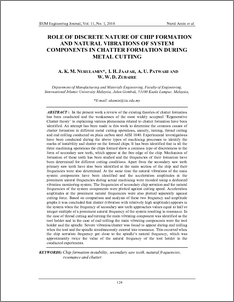Amin, A. K. M. Nurul and Jaafar, Israd Hakim and Patwari, Muhammed Anayet Ullah and Zubaire, W. W. D.
(2010)
Role of discrete nature of chip formation and natural vibration of system components in chatter formation during metal cutting.
IIUM Engineering Journal, 11 (1).
pp. 124-138.
ISSN 1511-788X
![[img]](http://irep.iium.edu.my/style/images/fileicons/application_pdf.png)  Preview |
|
PDF (Relationship of chip serration and system resonance frequency in machining chatter)
- Published Version
Download (1MB)
| Preview
|
Abstract
In the present work a review of the existing theories of chatter formation
has been conducted and the weaknesses of the most widely accepted ‘Regenerative
Chatter theory’ in explaining various phenomena related to chatter formation have been
identified. An attempt has been made in this work to determine the common causes of
chatter formation in different metal cutting operations, namely, turning, thread cutting
and end milling conducted on plain carbon steel AISI 1040. Experimental investigations
have been conducted during the above types of machining processes to identify the
marks of instability and chatter on the formed chips. It has been identified that in all the
three machining operations the chips formed show a common type of discreteness in the
form of secondary saw teeth, which appear at the free edge of the chip. Mechanism of
formation of these teeth has been studied and the frequencies of their formation have
been determined for different cutting conditions. Apart from the secondary saw teeth
primary saw teeth have also been identified at the main section of the chip and their
frequencies were also determined. At the same time the natural vibrations of the main
system components have been identified and the acceleration amplitudes at the
prominent natural frequencies during actual machining were recoded using a dedicated
vibration monitoring system. The frequencies of secondary chip serration and the natural
frequencies of the system components were plotted against cutting speed. Acceleration
amplitudes at the prominent natural frequencies were also plotted separately against
cutting force. Based on comparison and analysis of these two frequency and amplitude
graphs it was concluded that chatter (vibration with relatively high amplitude) appears in
the system when the frequency of secondary saw teeth approaches values equal to half or
integer multiple of a prominent natural frequency of the system resulting in resonance. In
the case of thread cutting and turning the main vibrating component was identified as the
tool holder and in the case of end milling the main vibrating components were the tool
holder and the spindle. Severe vibration/chatter was found to appear during end milling
when the tool and the spindle simultaneously entered into resonance. This occurred when
the chip serration frequency got close to the spindle’s natural frequency, which was
approximately twice the value of the natural frequency of the tool holder in the
conducted experiments.
Actions (login required)
 |
View Item |


 Download Statistics
Download Statistics Download Statistics
Download Statistics